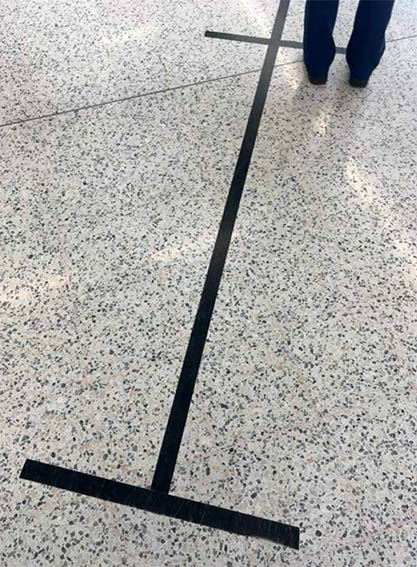Acceptable Blockage - Corona Edition
Matthew de Kersaint Giraudeau
We’re hard at work on a new symbolic language. It’s a visual dialect that draws on an existing vocabulary. It takes the form of public interventions made with spray paint, hazard tape, barriers, fencing and laminated signs. These constructions divide and block off parts of public space. They are physical barriers, but also readable signs. They tell us what they’re doing as they’re doing it. They are acceptable blockages.
The creators of this new language use it to tell us where to be, how to stand, how close is too close and how far is far enough. We all take notice of these constructions, and while we decode what they are saying we appreciate their prosaic aesthetics and occasional wit or grace, just as we sometimes notice their clumsy awkwardness or their failure to function.
A recurring motif in acceptable blockages is the triple layering of symbolic and actual barriers: written language, bright hazardous colours like red, yellow and black, and physical obstructions.
Some acceptable blockages remind us of magical curses or circles of protection. Abandon hope, all who enter here. And although social distancing measures are ultimately in place to save lives, the danger for the individual is more moral than mortal. There’s a new etiquette on our streets, in our parks and shops. We understand the rules and we submit to their authority.
The coronavirus and the subsequent restrictions on economic activity and individuals’ movements have caused a worldwide drop in crime rates. In the UK though, there has been a rise in calls to the police about anti-social behaviour, the definition of which has now expanded to include being in a group of more than two people, or using a fenced off piece of gym equipment in the park. Temporarily, we’re allowed to indulge our prejudices (they don’t look like a family group, they shouldn’t be sitting down, they’re too close to me) and assume the worst about the intentions of other people.

I once spoke to a Senior Infrastructure Officer in the British Army. He had overseen the building of Camp Bastion, the British Army air base in the Afghanistan war. He talked about the system of barriers they had at the edge of the camp. Some were forms of physical protection: ditches, barbed wire, solid fences, but the first thing you saw at each entry point was what the colonel called a ‘flimsy finger barrier’ - the sort of thing you see at a multi-story carpark. It wouldn’t stop anyone who wanted to smash through but it’s function was symbolic. It determined the intention of people entering the camp, and driving through the barrier triggered an aggressive response from the guards. Friend or foe?
According to the Behavioural Insights Team (the former government ‘nudge’ department now operating as a profit making consultancy) young men are the most likely social group to break social distancing rules. Of course they are. Our politics and economics revolves around the figure of the youthful, radical man, a rule breaker, a decider, an outlier. Move fast and break things. Don’t follow the herd. Make your own way.
In the end, anger felt towards those of us who do not obey the acceptable blockages is performative rather than punitive. Social distancing is a numbers game, one person doing pull ups, or standing too close doesn’t change the state of play. We turn our frustration into outrage on social media or in heated conversations with friends and family. In a way, we are reiterating the rules to ourselves as much as anyone else.
Some of us wilfully ignore the blockages, most of us acquiesce to their stated desires, but all of us recognise that a language has formed up, and it can only enforce the rules through consent. The efficacy of acceptable blockages relies on the idea that we can exercise collective restraint in return for security. That assumption ignores 30 years of individualist ideology pumped into the cultural ether by capitalism, but in general our adherence to the rules shows that we have, for the most part ignored neoliberalism's demand that there be no such thing as society.
Some acceptable blockages are hastily assembled - flapping hazard tape on the swings, carelessly applied gaffa on the floor of the supermarket. But some are things of beauty. There’s satisfaction in seeing a bench rendered perfectly inoperative with tight loops of yellow and black hazard tape, or casting your eyes across a field of fenced off picnic benches.
My collection of photos comes from a call out on Twitter and Instagram. I’m grateful for people’s contributions, and I get the sense that people are happy to share. It is gratifying to know that other people have seen what we’ve seen. These images document a distinct set of public sculptures, and a new dialect of acceptable blockages that speaks to our situation. Posting pictures of acceptable blockages online is part of the interpretation and dissemination of this symbolic language, but it’s also a moment of connection between individuals, distanced but not isolated. 
Matthew de Kersaint Giraudeau creates sculptures, drawings, performances and films. His work addresses ugliness and taste, negative affective states, and the ambiguities of language and objects. He is a postgraduate researcher at Kingston School of Art.
www.dekersaint.com
If you want to add to the archive of acceptable blockages, post your picture on social media with the hashtag
#acceptableblockage, or send them to Matt on Twitter or Instagram
This interview features in the Spring/Summer 2020 edition of the Sluice magazine.
